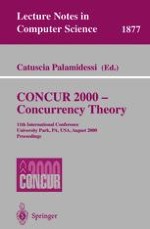This volume contains the proceedings of the 11th International Conference on Concurrency Theory (CONCUR 2000) held in State College, Pennsylvania, USA, during 22-25 August 2000. The purpose of the CONCUR conferences is to bring together researchers, developers, and students in order to advance the theory of concurrency and promote its applications. Interest in this topic is continuously growing, as a consequence of the importance and ubiquity of concurrent systems and their - plications, and of the scienti?c relevance of their foundations. The scope covers all areas of semantics, logics, and veri?cation techniques for concurrent systems. Topics include concurrency related aspects of: models of computation, semantic domains, process algebras, Petri nets, event structures, real-time systems, hybrid systems, decidability, model-checking, veri?cation techniques, re?nement te- niques, term and graph rewriting, distributed programming, logic constraint p- gramming, object-oriented programming, typing systems and algorithms, case studies, tools, and environments for programming and veri?cation. The ?rst two CONCUR conferences were held in Amsterdam (NL) in 1990 and 1991. The following ones in Stony Brook (USA), Hildesheim (D), Uppsala (S), Philadelphia (USA), Pisa (I), Warsaw (PL), Nice (F), and Eindhoven (NL). The proceedings have appeared in Springer LNCS, as Volumes 458, 527, 630, 715, 836, 962, 1119, 1243, 1466, and 1664.
